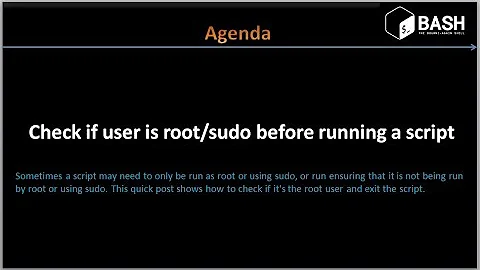How to securely automate running commands as root with "sudo su -"?
Solution 1
This isn't the best way to do it. However, your approach does not have the defect you claim. When you run
echo myPassword | sudo -S ls /tmp
the password never appears as the argument of an external command: all shells out there (except for some installations of BusyBox — it depends on a compilation option) have echo built in.
Solution 2
What you are trying to do is insecture in itself and really shouldn't be done.
In that light, maybe you want to rethink your requirements on "secure". Why on earth bother with sudo? You can set up a (second) SSH server which accepts login as root user, but with public key authentication only. That way you don't need to transmit passwords at all and just log in as user root and run your commands. You can simply
- copy the config from your present ssh server, which is most likely stored under
/etc/ssh/sshd_config, - modify it to
- allow root login,
- allow public key authentication,
- deny password authentication,
- make it listen on a different port, for example 666
- start a new
sshdinstance making it use your new alternate config file using the-foption.
Then you set up public key authentication so that you can ssh root@server -p 666 "rm -rf /" from your desktop machine without the need for sudo and a password.
Good Riddance :-)
Solution 3
It would be best to design your automation such that it's fired off from crontab on the server itself.
Another possibility is to create a setUID wrapper (which can just be something like a C program that calls execv("/path/to/script",argc,argv); or the like) for the root-required commands, and only allow your automation users to run it via group permissions, e.g.
chown root /usr/local/sbin/trustedWrapper
chmod 4750 /usr/local/bin/trustedWrapper
chgrp scriptrunners /usr/local/bin/trustedWrapper
As a last resort, configure sudo to not require a password for the user, by adding the NOPASSWD option to their sudoers entry, e.g.
admin ALL=NOPASSWD:ALL
although you should probably restrict the runnable programs list to only the ones that should be accessible via automation. For extra security, you will probably want to disable password logins for this user and ONLY allow login via ssh key.
Solution 4
I actually use python fabric and capistrano. They're both fairly easy to learn and will make your life a lot easier.
Related videos on Youtube
gasko peter
Updated on September 18, 2022Comments
-
gasko peter over 1 year
hint (on client side, how to encrypt files/pwd's):
# encrypt pwd with ssh key: openssl rsa -in ~/.ssh/id_rsa -outform pem > ~/.ssh/TEMP-id_rsa.pem 2>/dev/null openssl rsa -in ~/.ssh/id_rsa -pubout -outform pem > ~/.ssh/TEMP-id_rsa.pub.pem 2>/dev/null echo $PWDHERE > ~/.ssh/TEMP.pwd openssl rsautl -encrypt -pubin -inkey ~/.ssh/TEMP-id_rsa.pub.pem -in ~/.ssh/TEMP.pwd -out ~/.ssh/TEMP.pwd.enc 2>/dev/null rm ~/.ssh/TEMP.pwd > /dev/null 2>&1 # decrypt: PWDHERE=`openssl rsautl -decrypt -inkey ~/.ssh/TEMP-id_rsa.pem -in ~/.ssh/TEMP.pwd.enc`So.. it would be a very easy task to automate running commands via SSH on servers with the root user on server side (in the end we need to run a script from a desktop machine on server side with root user, but running a command automated would be enough to know, from there we could do the thing..).
BUT: the Question is that how to securely automate running commands with root if we have to "sudo su -" first on the server, and give password in it?
UPDATE: modifying the sudoers file is not an option. (maybe puppet can do this??)
UPDATE#2:
echo myPassword | sudo -S ls /tmpisn't secure AFAIK. (because if other users 'ps -ef' they could see the pwd for a little time?) So that's not a solution either.
UPDATE#3: I want to do "Remote control a machine(s) with ad-hoc commands"
-
peterph about 11 yearsStore passphrase in a file, then
cat file | sudo -S .... -
Amitav Pajni about 11 yearsIf you can't update the
sudoersfile, you can't really make this secure. Go fix that problem first.
-
-
gasko peter about 11 yearsCan ex.: fabric handle that the servers has different passwords when using sudo??
-
gasko peter about 11 yearsI hope this is true :D
-
psusi about 11 yearsScripts can't be suid.
-
Daniel about 11 yearsI knew that, but I brainfarted when I wrote the answer. Fixed, and also expanded a bit on what I meant by "wrapper," thanks.
-
gasko peter about 11 yearsRemote control a machine(s) with ad-hoc commands


![How To Grant Sudo Access to a Normal User in RHEL/CentOS 8[Hindi]By Karun Behal](https://i.ytimg.com/vi/XeEqrI_tYQw/hqdefault.jpg?sqp=-oaymwEcCOADEI4CSFXyq4qpAw4IARUAAIhCGAFwAcABBg==&rs=AOn4CLCEaEBq9oYmD0tqAEbHEmFpNEEKoA)

